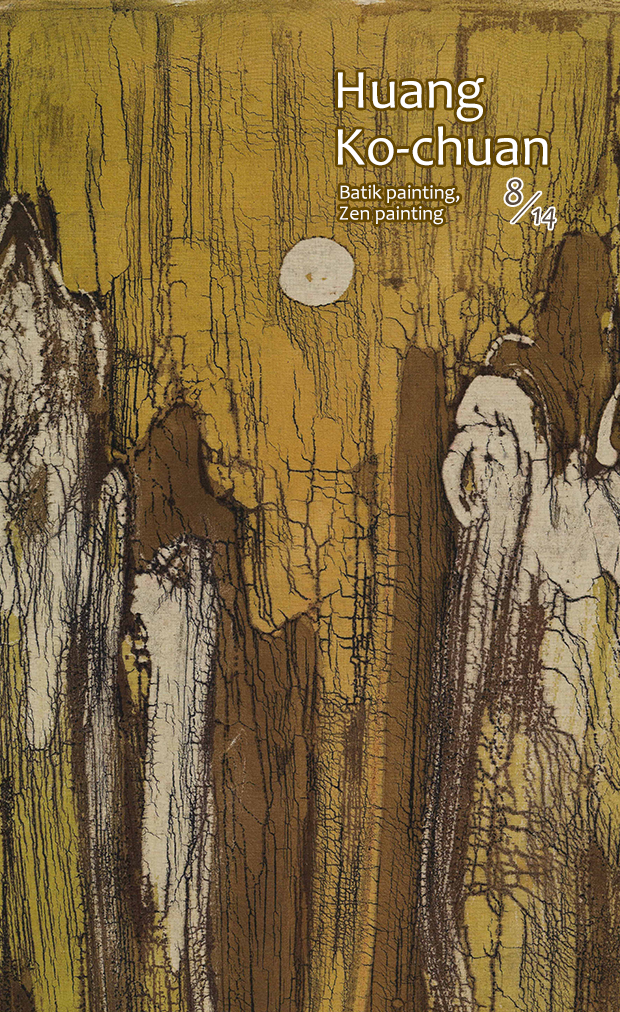

Huang Ko-chuan (1919-2010) — given name Changgeng, professional name San-shan — was born in Fuzhou City in China's Fujian Province on August 14, 1919, and lived to the age of 91. Later known for his artistic experimentation, the seeds of this inventive spirit emerged early through Huang's boyhood passion for science. Huang graduated from the fine art department of Fujian Normal School in 1943 and spent the years during World War II creating propaganda in a range of media — including illustrations, woodcuts, theater plays and print media — to help the government boost morale. Soon after taking up his residence in Taiwan in 1949 as a reporter and then stayed in Taiwan, Huang began dedicating years to Taiwanese ice-crack batik painting, traditional Chinese ink-wash painting, oil painting and mixed media work. He was involved in many milestones in the development of art in Taiwan, including the Taiwan Modern Painting Movement. Between 1958 and 1962, Huang set up a number of art associations, including the Chinese Watercolor Association, the ROC Painting Society and the Taiwan Society of Printmaking, while also serving as a councilmember at the Graphic Design Association of ROC and the Photographic Society of China, and promoting cultural exchanges between Taiwan and South Korea. While making these outstanding contributions to the development of Taiwan's art scene, Huang also realized his calling to enrich life through art. Through participating in many international art exhibitions in the 1960s, Huang discovered there was considerable interest in Eastern batik works in the West, but that many artists found the complexity of the process unfriendly. In 1963, he developed a technique he called Taiwanese ice-crack batik, significantly simplifying the process by eliminating the need to dye through immersion or remove the wax by steaming, making batik far more accessible and helping artists better control the “ice-crack” effect.
The essence of batik works is the highly textured “ice-crack” pattern, which fits in perfectly with the spirit of contemporary ink-wash painting and attempts to blend Eastern and Western aesthetics. To promote this new technique, Huang exhibited pieces both domestically and internationally and offered classes as far afield as Canada, South Korea and Malaysia.
In 1985, Huang was introduced to Buddhist teachings and found deep resonance with the Zen tradition. He resolved to depict the monk Bodhidharma in various ways, particularly through an endearing rendering of the monk in his “Dharma Zen” series of paintings to encapsulate Zen teachings with his brush. Influenced by what was happening in the art world overseas, Huang in 1990 started exploring mixed media approaches, especially in his works depicting lotuses. In 2006 at the advanced age of 87, he began promoting the idea of using oil paints and materials in traditional Chinese ink-wash painting in the hopes of making the style more accessible to the West. This involved replacing ink with oils, painting on canvas instead of paper and blending Eastern and Western painting techniques, with the goal of forming a new school of painting.
Huang devoted his life to exploring new creative approaches and breaking down barriers. His experimentation opened new avenues for traditional culture by integrating ancient and contemporary elements and exploring the intersection between Eastern and Western art. Throughout his long career, he achieved this through blending Eastern and Western painting techniques, using new media and modern forms of expression, promoting cultural exchanges, and creating new artistic vocabularies with ice-crack batik painting, Dharma Zen painting, mixed media and the use of oils in traditional Chinese ink-wash painting.
His works have been selected for major international art exhibitions, including the São Paulo Art Biennial in Brazil and the Museo Nacional del Prado in Spain, as well as the National Arts Exhibition in Taiwan, where he enjoyed lifetime qualification status until the exhibition was discontinued in 2007. For his many diverse contributions, Huang is regarded as a pioneer of transdisciplinarity and fusion art in Taiwan.
In 1969, he was invited by the museum to participate in an exhibition on Chinese contemporary art in the Museo Nacional del Prado, Spain, and while there, he also showed his work around Europe. In 2020, Huang's family donated 100 artworks to the National Museum of History, including 61 pieces that entered the museum's collection and 39 pieces that are stored in the archives for research purposes. In total, the museum has 101 works by Huang Ko-chuan in its collection.










